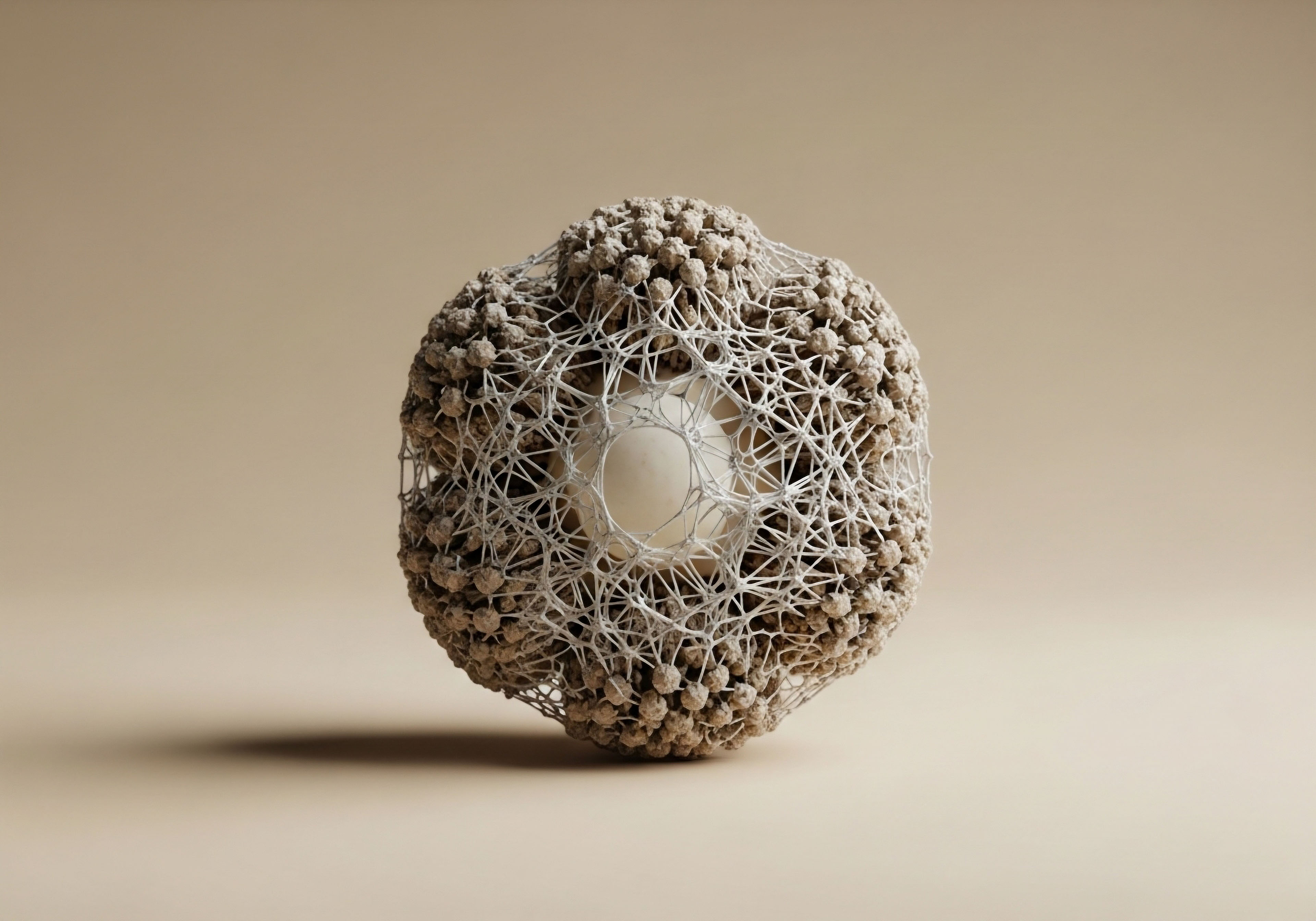

Fundamentals
You may have noticed a change in the mirror. It could be subtle, a slight alteration in texture or thickness, or perhaps more pronounced, a visible thinning where there was once fullness. This experience, the observation of your hair’s changing character, is a deeply personal and often disconcerting one.
Your body is communicating with you through one of its most visible tissues. Understanding the language of this communication is the first step toward reclaiming a sense of control and well-being. The story of your hair is inextricably linked to the story of your hormones, the silent chemical messengers that conduct the symphony of your body’s daily functions.
When you begin a hormonal optimization protocol, you are intentionally adjusting this symphony. The changes you see in your hair are a direct reflection of this recalibration.
Every single strand of hair on your head operates on a cyclical timeline, a process of growth, transition, and rest. This is known as the hair growth cycle, and it is exquisitely sensitive to your internal endocrine environment.
Your hormones are the primary regulators of this cycle, determining how long each strand stays in its active growth phase, when it transitions, and when it is shed to make way for new growth. Thinking of your hair’s beauty as a static feature is a common perspective. A more accurate and empowering view is to see it as a dynamic, living system that provides constant feedback about your internal health.
The changes in your hair’s texture and density while on hormonal therapies are direct signals from your body’s shifting internal environment.

The Three Phases of Hair Follicle Life
To grasp how hormonal shifts affect your hair, it is useful to understand the three primary phases of its life. Each follicle on your scalp operates independently, following its own schedule. This asynchrony is why a healthy scalp maintains consistent coverage.
- Anagen Phase This is the active growth phase. Cells in the hair bulb are dividing rapidly, creating new hair. The length of this phase determines the maximum length your hair can reach. For scalp hair, this phase can last for several years. Hormones like estrogen play a significant role in keeping hair in this phase for longer periods.
- Catagen Phase This is a short, transitional phase that marks the end of active growth. The hair follicle shrinks and detaches from the dermal papilla, which is its blood supply. This phase typically lasts for a few weeks.
- Telogen Phase This is the resting phase. The hair follicle is dormant, and the hair strand is held in place, awaiting the signal to be shed. This phase can last for several months. Following the telogen phase, the old hair falls out, and a new anagen hair begins to grow from the same follicle, restarting the cycle.
When hormonal balance is optimal, a large percentage of your hair follicles are in the anagen phase, leading to a full, healthy appearance. When this balance is disturbed, either by natural life transitions or by therapeutic interventions like HRT, the timing of these cycles can be altered dramatically.
More follicles might be pushed prematurely into the telogen phase, resulting in noticeable shedding, a condition known as telogen effluvium. Alternatively, the anagen phase might be shortened, leading to finer, shorter hairs over time.

Introducing the Key Hormonal Messengers
Your hair follicles are covered in receptors, tiny docking stations for specific hormones. When a hormone binds to its receptor, it delivers a message that alters the follicle’s behavior. The primary hormones that influence hair are estrogens, progesterone, and androgens like testosterone and its potent derivative, dihydrotestosterone (DHT).
Estrogens, for instance, are generally considered hair-protective. They help to prolong the anagen phase, which is why many women experience thicker, more lustrous hair during pregnancy when estrogen levels are high. Conversely, the drop in estrogen during menopause is a primary contributor to hair thinning.
Androgens have a more complex and site-specific role. Testosterone is responsible for the growth of thick, terminal hair on the body and face. On the scalp, however, its conversion to DHT can have the opposite effect in genetically susceptible individuals, leading to the progressive shrinking of hair follicles, a process called miniaturization.
This is the central mechanism behind androgenetic alopecia, or pattern hair loss, in both men and women. Understanding these fundamental players and their mechanisms is the foundation for comprehending how your specific hormonal protocol is influencing the health and appearance of your hair.


Intermediate
Moving beyond the foundational concepts of hormonal influence, we can examine the specific clinical protocols of endocrine system support and their direct biochemical impact on hair follicles. When you embark on a hormonal optimization protocol, you are making precise adjustments to a complex signaling network.
The response of your hair is a predictable, albeit sometimes unwelcome, consequence of these adjustments. The key is to understand the “why” behind these changes, connecting the therapeutic agent to the cellular response within the scalp.
The relationship between HRT and hair health is deeply personal and depends on a combination of factors, including the specific hormones used, the dosage, the delivery method, and your own genetic sensitivity to hormonal fluctuations. For some, hormonal recalibration may lead to improved hair density and texture.
For others, particularly those with a predisposition to androgenetic alopecia, it can trigger or accelerate thinning. The goal of a well-designed protocol is to achieve systemic balance while mitigating unwanted localized effects, such as those on the hair.

The Androgenic Component Testosterone and DHT
For both men and women undergoing testosterone replacement therapy (TRT), understanding the role of androgens is paramount. Testosterone itself is not the primary culprit in scalp hair loss. The issue arises from its conversion into a more potent androgen, dihydrotestosterone (DHT), by an enzyme called 5-alpha reductase, which is present in the scalp’s oil glands and hair follicles.
DHT binds to androgen receptors in genetically susceptible hair follicles with high affinity, initiating a cascade of events that leads to follicular miniaturization. This process shortens the anagen (growth) phase and prolongs the telogen (resting) phase. Over successive cycles, the affected follicles produce hairs that are shorter, finer, and less pigmented, eventually becoming so small that they no longer penetrate the skin’s surface. This is the clinical picture of androgenetic alopecia.
Systemic hormonal therapies create a new biochemical environment that directly instructs the behavior of every hair follicle on your body.
In men’s TRT protocols, which often involve weekly intramuscular injections of Testosterone Cypionate, the resulting increase in serum testosterone can lead to a corresponding increase in DHT levels. This is why medications like Anastrozole are sometimes included. Anastrozole blocks the conversion of testosterone to estrogen, which can indirectly affect the overall hormonal balance.
For individuals concerned about hair loss, a 5-alpha reductase inhibitor like Finasteride might be considered to specifically block the conversion of testosterone to DHT. In women’s TRT, even the low doses of Testosterone Cypionate (typically 10-20 units weekly) can be enough to trigger hair thinning in sensitive individuals, as the relative increase in androgens can disrupt the previously protective estrogen-androgen ratio.

How Do Specific Hormones Alter Hair Follicle Dynamics?
Each class of hormone introduced through HRT sends a distinct signal to the hair follicle. Understanding these signals allows for a more informed approach to managing your hair’s response.
| Hormone/Hormone Class | Primary Mechanism of Action on Hair Follicles | Potential Clinical Outcome on Scalp Hair |
|---|---|---|
| Estrogen | Binds to estrogen receptors, prolonging the anagen (growth) phase and increasing the production of growth factors. It can also suppress the local production of DHT. | Increased hair density, thickness, and growth rate. A decline in estrogen can lead to thinning. |
| Progesterone | Can compete with androgens for the 5-alpha reductase enzyme, potentially decreasing the conversion of testosterone to DHT at the follicular level. | Generally supportive of hair health, though some synthetic progestins may have androgenic properties that can negatively affect hair. |
| Testosterone | Serves as the precursor to DHT. In its own right, it promotes the growth of coarser, darker hair on the body and face. | On the scalp, its effect is primarily indirect, through its conversion to DHT, which can lead to hair loss in susceptible individuals. |
| Dihydrotestosterone (DHT) | Binds strongly to androgen receptors in scalp follicles, shortening the anagen phase and causing progressive follicular miniaturization. | The primary driver of androgenetic alopecia (pattern hair loss) in both men and women. |
| Thyroid Hormones | Essential for regulating cellular metabolism and protein synthesis within the hair follicle. They support the anagen phase. | Both hypothyroidism (underactive) and hyperthyroidism (overactive) can disrupt the hair cycle, often causing diffuse shedding (telogen effluvium). |

Individual Sensitivity a Key Variable
It is important to recognize that two individuals on the exact same hormonal protocol can have vastly different outcomes regarding their hair. This variability is largely due to genetic factors that determine the number and sensitivity of androgen receptors on the hair follicles.
If your genetic blueprint includes high follicular sensitivity to DHT, even a modest increase in testosterone from a low-dose protocol can be sufficient to trigger a thinning process. This is why a personal and family history of hair loss is a critical piece of information in designing a hormonal optimization strategy. The process is a dialogue between the therapeutic intervention and your unique biological constitution.


Academic
A sophisticated understanding of hormonal replacement therapy’s impact on hair requires an examination of the intricate molecular dialogues occurring within the pilosebaceous unit, the anatomical structure that contains the hair follicle. The clinical outcomes we observe, such as changes in hair density and texture, are macroscopic manifestations of complex events at the cellular and genetic levels.
The introduction of exogenous hormones, as in TRT or other hormonal protocols, fundamentally alters the local signaling environment of the scalp, thereby modulating gene expression, growth factor cascades, and inflammatory pathways that govern follicular cycling and viability.

The Follicular Microenvironment a Systems Biology Perspective
The hair follicle is not an isolated structure. It exists in a dynamic microenvironment, communicating constantly with the surrounding dermal and epidermal cells through a network of autocrine and paracrine signaling molecules. The systemic hormonal milieu, governed by the Hypothalamic-Pituitary-Gonadal (HPG) axis and modulated by therapeutic interventions, sets the overarching tone. Local enzymes within the follicle, such as 5-alpha reductase and aromatase, then fine-tune this signal, converting precursor hormones into more potent local actors.
For example, in androgenetic alopecia, the core mechanism involves the local conversion of testosterone to dihydrotestosterone (DHT) by 5-alpha reductase type 2. Upon binding to the androgen receptor (AR) in dermal papilla cells, the DHT-AR complex translocates to the nucleus and acts as a transcription factor.
It modulates the expression of numerous genes, including those for various growth factors. One critical consequence is the upregulation of transforming growth factor-beta (TGF-β), a potent inhibitor of epithelial cell proliferation, which contributes to the premature termination of the anagen phase.
Simultaneously, the expression of supportive factors like Insulin-like Growth Factor-1 (IGF-1), which promotes anagen, may be downregulated. This altered secretome from the dermal papilla then instructs the follicular stem cells and matrix keratinocytes to slow proliferation and initiate the involution characteristic of the catagen phase.
Hormonal therapies initiate a cascade of genomic and non-genomic events within the dermal papilla, altering the very blueprint for follicular growth.

What Is the Role of Inflammation and Vascularity?
Recent research has highlighted the role of microinflammation and vascular changes in the pathophysiology of hormonally-driven hair loss. Scalp biopsies from individuals with androgenetic alopecia often reveal a perifollicular inflammatory infiltrate, composed of lymphocytes and mast cells. Androgens may promote this inflammatory state.
This chronic, low-grade inflammation can lead to fibrosis of the connective tissue sheath surrounding the follicle, progressively strangling its blood supply and hindering its ability to cycle properly. This fibrotic process may represent the final, irreversible stage of follicular miniaturization.
Furthermore, vascularity is critical. The dermal papilla is highly vascularized, and this blood supply is essential for delivering the oxygen and nutrients required for the high metabolic activity of anagen. Vascular Endothelial Growth Factor (VEGF) is a key regulator of this process. Estrogen has been shown to upregulate VEGF expression, contributing to its hair-protective effects.
Conversely, androgens like DHT may have an anti-angiogenic effect in the scalp, reducing blood flow to the follicle and further compromising its vitality. Some therapeutic agents, like Minoxidil, are thought to work in part by enhancing local blood flow and upregulating VEGF, counteracting this deficit.

Cellular Mechanisms of Hormonal Action on Hair
The following table provides a granular view of the molecular events initiated by key hormones within the hair follicle, connecting the systemic signal to the specific cellular response.
| Hormonal Signal | Target Cell/Receptor | Key Molecular Pathway | Resulting Effect on Follicle |
|---|---|---|---|
| Dihydrotestosterone (DHT) | Androgen Receptor (AR) in Dermal Papilla Cells | Nuclear translocation of DHT-AR complex; modulation of gene transcription. Upregulation of TGF-β1, TGF-β2, DKK-1. Downregulation of IGF-1. | Induction of catagen, shortening of anagen, progressive miniaturization of the follicle. |
| Estradiol (E2) | Estrogen Receptor Alpha/Beta (ERα/ERβ) in Follicular Keratinocytes and Dermal Papilla | Upregulation of IGF-1 and VEGF. Suppression of pro-inflammatory cytokines. Direct genomic and non-genomic signaling. | Prolongation of the anagen phase, increased follicular vascularity, and enhanced hair shaft thickness. |
| Progesterone | Progesterone Receptor (PR); also competes for 5-alpha reductase | Inhibits 5-alpha reductase, reducing local DHT synthesis. May also have direct anti-proliferative effects at high concentrations. | Blocks a key pathway in androgen-mediated hair loss, potentially preserving the anagen phase. |
| Growth Hormone Peptides (e.g. Sermorelin, CJC-1295) | GHRH Receptor, leading to downstream IGF-1 release | Stimulation of systemic and local IGF-1 production. IGF-1 is a potent mitogen for follicular cells. | Promotion of anagen phase and potential increase in hair shaft diameter, supporting overall hair health. |
This systems-level view reveals that hair’s response to hormonal therapy is a complex biological phenomenon. It involves a delicate balance between systemic hormonal levels, local enzymatic activity, receptor density, growth factor signaling, and the inflammatory state of the scalp. A truly personalized approach to hormonal optimization must consider these interconnected pathways to maximize therapeutic benefits while preserving the vitality and beauty of the hair.

References
- Trüeb, Ralph M. “Molecular mechanisms of androgenetic alopecia.” Experimental gerontology vol. 37,8 (2002) ∞ 981-90.
- Grymowicz, Monika, et al. “Hormonal Effects on Hair Follicles.” International Journal of Molecular Sciences, vol. 21, no. 15, 2020, p. 5342.
- Ohnemus, U. et al. “The hair follicle as a signaling center.” Journal of Investigative Dermatology Symposium Proceedings. Vol. 11. No. 1. Elsevier, 2006.
- Stevenson, S. and J. Thornton. “Effect of estrogens on skin aging and the potential role of SERMs.” Clinical interventions in aging 2.3 (2007) ∞ 283.
- Kaufman, Keith D. “Androgens and alopecia.” Molecular and cellular endocrinology vol. 198,1-2 (2002) ∞ 89-95.
- Inui, S. and S. Itami. “Androgen actions on the human hair follicle ∞ perspectives.” Experimental dermatology vol. 22,3 (2013) ∞ 168-171.
- Randall, Valerie A. “Androgens and hair growth.” Dermatologic therapy vol. 21,5 (2008) ∞ 314-328.
- Glaser, R. L. et al. “Hormone replacement therapy and the skin.” Journal of the American Academy of Dermatology 51.3 (2004) ∞ 471-473.

Reflection
You have now journeyed through the intricate biological pathways that connect your internal hormonal state to the visible vitality of your hair. This knowledge transforms your perspective. The changes you observe are no longer mysterious or arbitrary events, but rather a coherent set of signals from a body in dialogue with itself.
Your hair becomes a biomarker, a tangible indicator of your systemic health that you can learn to read with clarity and confidence. This understanding is the first, most critical step. The path forward involves continuing this dialogue, partnering with clinical expertise to interpret these signals and refine your protocol. Your health journey is uniquely yours, and the power to navigate it with intention lies in the synthesis of this scientific knowledge with your own lived experience.



